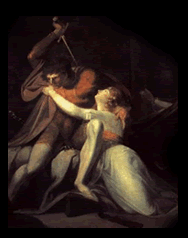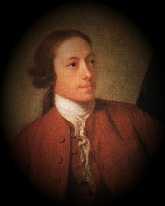|
My Immortal

According to Joseph Addison, an eighteenth-century journalist and critic, the Gothic
contained "all the extravagances of an irregular fancy." Although Addison meant this as a criticism, for the Romanticists
of the next generation it was a compliment. For them, the term "Gothic" suggested whatever was medieval, natural, primitive,
wild, free, authentic, romantic, various, rich, mysterious. The word "Gothic" originally referred to the Goths, a Germanic
tribe, then came to signify "Germanic," then "medieval." Thus, originally most Gothic novels were set in the middle
ages; now the term refers more to atmosphere and setting. Often such novels incorporate events which are uncanny or
macabre or melodramatically violent, and they often deal with aberrant psychological states.
C. Hugh Holman's Handbook to Literature
notes that "magic, mystery, and chivalry are the chief characteristics" of the Gothic novel. The atmosphere is often
brooding and filled with unknown terror. Horrors frequently abound: a suit of armor may come to life; ghosts,
complete with clanking chains, may walk the halls of a castle; women may be entombed in dungeons. Frequently the emphasis
is on setting and story rather than characterization.
What makes a Gothic work is a combination of at least some of these elements:
a castle, ruined or intact, haunted or not.
ruined buildings which are sinister or which arouse a pleasing melancholy.
dungeons, underground passages, crypts, and catacombs which, in modern houses, become spooky basements or attics.
labyrinths, dark corridors, and winding stairs.
shadows, a beam of moonlight in the blackness, a flickering candle, or the only source of light failing (a candle blown
out or an electric failure).
wild landscapes, like rugged mountains, thick forests, or icy wastes, and extreme weather.
omens and ancestral curses.
magic, supernatural manifestations, or the suggestion of the supernatural.
a passion-driven, wilful villain-hero or villain.
a curious heroine with a tendency to faint and a need to be rescued frequently.
a hero whose true identity is revealed by the end of the novel.
horrifying (or terrifying) events or the threat of such happenings.
The Castle of Otranto

|
| . |
The English Gothic novel began with Horace Walpole's The Castle of Otranto (1765), which was enormously popular
and quickly imitated by other novelists and soon became a recognizable genre. To most modern readers, however, The
Castle of Otranto is dull reading; except for the villain Manfred, the characters are insipid; the action moves at a fast
clip with no emphasis or suspense, despite the supernatural manifestations and a young maiden's flight through dark vaults.
But contemporary readers found the novel electrifying original and thrillingly suspenseful, with its remote setting, its use
of the supernatural, and its medieval trappings, all of which have been so frequently imitated and so poorly imitated that
they have become stereotypes. The genre takes its name from Otranto's medieval–or Gothic–setting.
|
 |
|
|
|
|
three good examples of gothic
though in fragmentary form
An outstanding introduction to
and overview of Gothic literature.
Includes an annotated bibliography
and excerpts from a number of
primary and secondary texts.
A student site which features
brief introductory essays on
some major figures in the
Gothic tradition.
this site is devoted to the study
of Gothic fiction in England
from 1764 to 1840, it is intended
to provide students and scholars
of the Gothic novel access to the
growing number of Gothic resources
available on the web.
Devoted to the expansion and
dissemination of information on
all aspects of the Gothic.
|

|
|
|
a complete e-text of this classic
from bibliomania
a biographical essay
by Paul Baines,
University Liverpool

|
|
 |
|
|
 |
|
|
|

